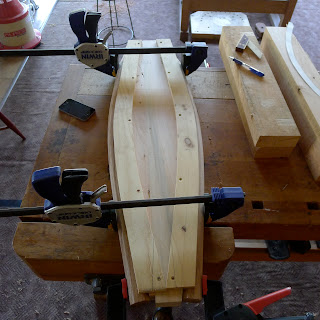In amongst a few Perches, Shaker furniture and oval boxes, cutting boards and home-wares I've been slowly making one Pete Galbert's Crested Rocking Chairs.
This is the rocker that I learnt to make from Pete himself in his then newly set up chair making workshop in Sterling, Massachusetts. According to Pete, I was the first person to make a chair in that shop for about 150 years or so. It turned out it had belonged to Newton Burpee, one of Sterling's very original Windsor chair makers of the late 1700 to early 1800's. Incredible stuff.
Anyway, not having access to green ( freshly felled, not the colour.... ) White and Red Oak and magnificent Butternut that I used for my American chair, I am substituting both for timbers I have milled here over the past few years. For the seat I have substituted the Butternut for 100+ year old Elm, which hailed from Daylesford, just 25mins down the road from us. The rest of the chair will be made from select Pin Oak. This particular log was one that I had salvaged from the Domain Gardens, just North of the gates to Government House. I don't have much of it left now, so it's pretty valuable to me.
GIven that the timber is limited and the process is relatively complex, from a Windsor chair making persepective, I have been taking my time to ensure that there will be no errors. A simple error in a perch or continuous arm chair merely means making a new part from readily available timber. Making an error with the Crested Rocker means expensive firewood and re-making steam bent parts from my limited supply.
I'm not intending on a blow by blow account of how the chair was made, but just thought I'd show a few photos of the Rocker as it takes shape. Last post saw the seat bowl roughed out.
Here is the seat fully shaped and ready for final smoothing with card scrapers and light sanding.
The grain pattern in the Elm is outstanding.
The stiles are steam bent as octagons which allows ease of working through other stages of their shaping and fitting to the chair.
Reaming the stiles into the seat is a little complex due to the stiles being curved and not in a straight axis. As well as being accurately raked to the desired angle they also must be parallel in both planes, the crest rail parallel to the seat and splayed correctly to ensure the crest tenons fit accurately into the mortises cut into the stiles. So just a few things to watch for.....
Here are the stiles and crest from the top the chair with the stiles reamed. I use a pair of winding sticks to check alignment.
I have to step away from the rocker for a few days now as other projects are calling but stay tuned for the next instalment where I will have the arms posts reamed, arm paddles reamed and shaped and a few of the spindles roughed out.






The figure in the seat is quite beautiful.
ReplyDeleteJP
Thanks Jack, if there's one timber I like in a Windsor seat, it's Elm.
ReplyDeleteCheers
Glen
Glen, These look fantastic. I love this blog.
ReplyDeleteGreg
Cheers Greg. Much appreciated.
ReplyDelete